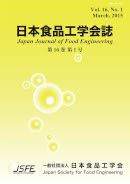Volume 16, Issue 1
Displaying 1-10 of 10 articles from this issue
- |<
- <
- 1
- >
- >|
Reviews
-
2015Volume 16Issue 1 Pages 1-12
Published: March 15, 2015
Released on J-STAGE: May 12, 2015
Download PDF (9050K) -
2015Volume 16Issue 1 Pages 13-15
Published: March 15, 2015
Released on J-STAGE: May 12, 2015
Download PDF (1110K) -
2015Volume 16Issue 1 Pages 17-26
Published: March 15, 2015
Released on J-STAGE: May 12, 2015
Download PDF (1884K) -
Some Applications to Retain the Quality of Fruits and Vegetables during Drying and Storage in Turkey2015Volume 16Issue 1 Pages 29-36
Published: March 15, 2015
Released on J-STAGE: May 12, 2015
Download PDF (1147K) -
2015Volume 16Issue 1 Pages 37-52
Published: March 15, 2015
Released on J-STAGE: May 12, 2015
Download PDF (3130K)
Original Papers
-
2015Volume 16Issue 1 Pages 55-59
Published: March 15, 2015
Released on J-STAGE: May 12, 2015
Download PDF (1331K) -
2015Volume 16Issue 1 Pages 63-70
Published: March 15, 2015
Released on J-STAGE: May 12, 2015
Download PDF (1063K)
Note
-
2015Volume 16Issue 1 Pages 71-74
Published: March 15, 2015
Released on J-STAGE: May 12, 2015
Download PDF (844K)
Review: Environment Conservation and Energy-saving Workshop
-
2015Volume 16Issue 1 Pages 75-78
Published: March 15, 2015
Released on J-STAGE: May 12, 2015
Download PDF (2322K)
-
2015Volume 16Issue 1 Pages 79-82
Published: March 15, 2015
Released on J-STAGE: May 12, 2015
Download PDF (1488K)
- |<
- <
- 1
- >
- >|
